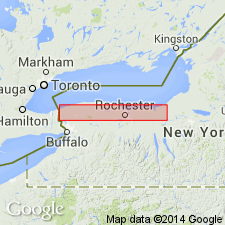
- Usage in publication:
-
- Webster Bed
- Modifications:
-
- Named
- Dominant lithology:
-
- Conglomerate
- AAPG geologic province:
-
- Appalachian basin
Summary:
Name Webster Bed is herein applied to thin hematitic, phosphatic conglomerate below the base of the Reynales Limestone of the Clinton Group. Type section is designated in the town of Webster, Monroe Co., NY. Unit is the local, highly attenuated equivalent of the Maplewood Shale. Bed is bluish gray to red and 10 to 20 cm thick and consists for the most part of limestone clasts. Base of the Webster is lithologically equivalent to the Densmore Creek Bed at the base of the Maplewood. Though thin, unit probably represents a considerable time interval as in some cases, at least three generations of phosphatization are evident. At Webster, NY, underlies the Wallington Member of the Reynales Limestone. Twenty km to the east, near Salmon Creek, underlies or is basal unit of a hematite referred to in this report as the Furnaceville Member of the Reynales. Eastward still, the Furnaceville becomes the basal member of the Bear Creek Shale and the Webster is still evident below. Overlies the Kodak Sandstone of the Medina Group and grades laterally into the Oneida Conglomerate at Martville, Cayuga Co. Age is Silurian (Llandoverian).
Source: GNU records (USGS DDS-6; Reston GNULEX).
For more information, please contact Nancy Stamm, Geologic Names Committee Secretary.
Asterisk (*) indicates published by U.S. Geological Survey authors.
"No current usage" (†) implies that a name has been abandoned or has fallen into disuse. Former usage and, if known, replacement name given in parentheses ( ).
Slash (/) indicates name conflicts with nomenclatural guidelines (CSN, 1933; ACSN, 1961, 1970; NACSN, 1983, 2005, 2021). May be explained within brackets ([ ]).

